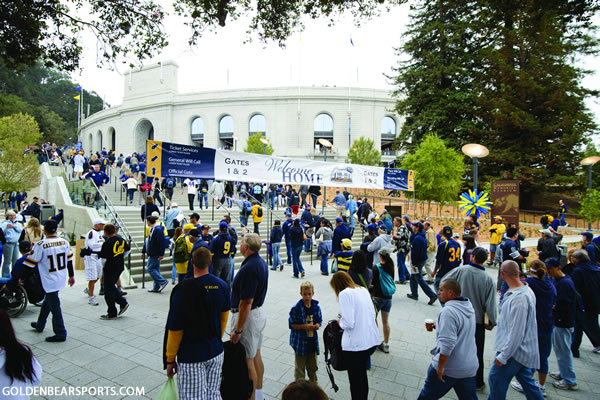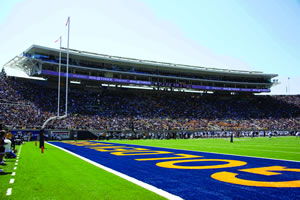

Some wanted to rebuild at another site, but Cal chose to address earthquake safety issues and refurbish its historic stadium at its original site on the Hayward Fault.
When the University of California began to look at rebuilding Memorial Stadium, no one expected a quick, easy project. The stadium sat on the Hayward Fault in an active earthquake zone, and had gone without major improvements since it opened in 1923.
And the 10-year journey from conception to completion didn’t disappoint. The $321 million project produced a series of obstacles that the school had to overcome, some 70 feet high among the campus treetops, where a lengthy tree sitters’ protest next to the stadium drew international attention.
“The shortest piece was the 21-month construction,” said Bob Milano Jr., Cal’s assistant athletic director of capital planning and management.

 |
Three new clubs are stacked on the west side; the University
Club deck (right) offers a picturesque exterior view.
Photos by: HNTB/UNIVERSITY OF CALIFORNIA |
In the end, Cal got what it wanted: It addressed the seismic safety issue through the upgrade, while providing a more enjoyable experience for fans. Building a true concourse with permanent concessions and restrooms finally brought the stadium up to date with other college football venues.
Upgrading those features alone was a vast improvement over the old stadium, where makeshift food stands could do little more than offer popcorn and lemonade. The toilets, mostly designed for men, had old wood partitions and low ceilings and were “awful,” said HNTB’s Joe Diesko, the project architect.
The old hallways around the stadium’s classic coliseum-style bowl were a scant 11 feet wide and “to call it a concourse was giving it too much credit,” Diesko said.
HNTB’s design called for gutting most of the stadium, lowering the field an average of four feet and creating a field wall to provide clear sight lines for those sitting closest to the field. In the old setup, about 4,000 fans sitting in the first eight to 10 rows along the sidelines could not see the game with players standing in front of them. Total seating has been reduced to about 63,000 from the stadium’s original 70,000 seats.
For players on the field, it “feels more big time, like you’re on stage … because you’re not at the same level as the fans,” Diesko said. “I don’t have a definition for what that means, but it’s definitely there.”
Developing accessible seating for wheelchair patrons was another important piece of the renovation after alumni informed Cal officials through focus groups that many of them could not attend games anymore because it was too difficult to navigate the stadium, Diesko said.
CALIFORNIA
Memorial Stadium
Built: 1923
Project cost: $321 million
Renovation designer: HNTB
Last major renovation: N/A
What’s new: Suites, viewed as a symbol
of elitism in the liberal bastion of Berkeley,
were not part of the stadium retrofit at a
school known as the “people’s university,”
said project architect Joe Diesko of HNTB.
Even the club seats were designed as part of
the seating bowl without being obtrusive. “Our
focus groups and research spoke very clearly
about that,” said Bob Milano Jr., Cal assistant
athletic director. “Those interested in buying
club seats wanted to sit outdoors and in large
groups.” The seats are centered on the 50-
yard line.
Premium seat details: 2,878 club seats,
about $2,750 to $15,400 annually; the school
had sold 1,745 through the end of June, according
to the athletics website.

Financing: The school initially sold bonds
to finance the project, with debt service to
be paid through revenue from seat
licenses (some paid over 30 years),
general ticket sales, concessions,
philanthropic gifts and TV
deals.
The three new clubs stacked on the stadium’s west side are tied to a long-term seat license program to finance construction (see box).
The stadium’s west wall was opened with arches built into the old facade to provide views over campus to the San Francisco skyline and the Golden Gate Bridge. Fans could never enjoy those views before the renovation. Now, “people can’t believe they are in the same place,” Diesko said.
Early in the process, there were concerns over whether the stadium should be rebuilt on the fault line. Internally, some Cal faculty wondered whether it made better sense for the university to build another stadium at a new location, Milano said.
Complicating matters was the stadium’s inclusion on the National Register of Historic Places, giving fuel to critics of the project who said the renovation would ruin the building, he said.
The city piled on with lawsuits filed over the project’s Environmental Impact Review, a document required for all new construction in California. Not to be outdone, the tree sitters delayed the project’s first phase by almost two years. A group of preservationists protested the removal of an oak grove to build the Simpson Center for Student Athlete High Performance next to the stadium. Hundreds of people lived in the trees from December 2006 until September 2008, when the few remaining protesters were removed from their roost.
During that time, the country fell into a recession. Construction prices dropped by 20 percent to 25 percent as contractors hungry for work gave bids far below estimates, Diesko said. As a result, officials got more bang for the buck in building the $15 million training center.
“The tree sitters actually helped the project,” he said. “There would have been chunks of that building unfinished and awaiting other funds as they might get donated.”








